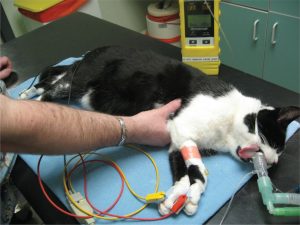ADV-Lesson 3- Ventilation
Ventilation

Ventilation is more effective with a cuffed endotracheal tube than via mouth to snout ventilation. Chest compressions should not be stopped to facilitate intubation. Staff should be trained to intubate a patient in lateral recumbency. It is recommended that you practice this frequently when intubating patients for elective anesthetic procedures. Primary respiratory arrest is more common in dogs and cats than in people. Since stroke volume in CPR only delivers 30% of normal volume, diverting blood to the periphery results in decreased perfusion to the core organs, such as the brain, heart and lungs. Increased intracranial pressure can result from cerebral vasodilation. In intubated patients, ventilation should be done at 10 breaths per minute, 1 breath every 6 seconds. This lower respiration rate helps avoid hyperventilation. Less CO2 is delivered to the lungs during CPR because the cardiac output is lower.
